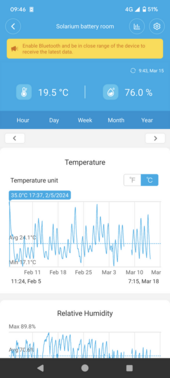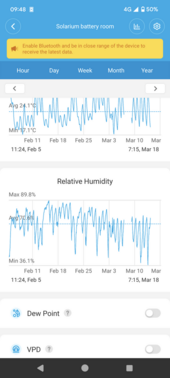totalconfusion
New Member
- Joined
- Dec 24, 2020
- Messages
- 62
The humidity seems high. How will this effect battery life?
I've been logging temperature and humidity for a short while on a new LiFePO4 installation
The Pylontech batteries are in an open frame rack. Everything is in a small room protected from direct sunlight and there's a fan running constantly pushing OUT, so as to induce air flow by creating negative pressure
I was considering hooking up the fan to the temperature sensor in the Cerbo and to have the fan only turn on after say 25 Celsius. Is there really any point in doing so? I guess you'd get more life out of the fan and save a small amount of electricity?
It's the Australian outback. Here is the data.


I've been logging temperature and humidity for a short while on a new LiFePO4 installation
The Pylontech batteries are in an open frame rack. Everything is in a small room protected from direct sunlight and there's a fan running constantly pushing OUT, so as to induce air flow by creating negative pressure
I was considering hooking up the fan to the temperature sensor in the Cerbo and to have the fan only turn on after say 25 Celsius. Is there really any point in doing so? I guess you'd get more life out of the fan and save a small amount of electricity?
It's the Australian outback. Here is the data.




